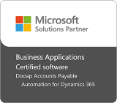
Sanna Kaarlejärvi, Dooap’s CFO and leading process consultant, visited the Exchange Summit 2016 event in Barcelona to update her views on e-invoicing.
The event focuses on the development of e-invoicing, but it also always includes presentations of new technologies and trends. Here is a summary of Sanna’s observations.
Development in e-invoicing – Latin America steamrollers others
- In Europe, e-invoicing has progressed slowly. Development has been done in workgroups, which publish recommendations that are not mandatory. In Latin America, development takes place under government mandate, which has led to e-invoicing having the largest proportion of all invoicing. The model seems to be working better than the European one.
- In Latin America and the emerging economies of Asia, many countries use the clearance model. The supplier first needs to send the invoice to the tax authority for approval, and only then can the supplier deliver the invoice to the customer. All this is done online. There are predictions that the same model would be usable and deployed in European countries with a large proportion of “gray economy” and a large national debt.
- During the past year, however, great strides have been taken in Europe to advance e-invoicing. In EU countries, it is becoming mandatory through EU legislation for public organizations to receive e-invoices in 2018. In many countries, this obligation has been extended to an obligation to send e-invoices, meaning a legal obligation to send e-invoices to public organizations. For example, in Spain this became mandatory since the beginning of 2015. France is the first European country to legislate mandatory e-invoicing between companies, too.
- The EU is drafting a block-wide e-invoicing format that will be the mandatory reception format between public organization procurement through a directive. In addition, the EU is forcing bidding for public procurement to happen electronically, aiming at making internal trade within the EU easier and more efficient.
- When following the development of e-invoicing, you should note that despite electronic invoicing, the process in many companies is reverted to a manual process as the invoices are still printed out or images included in the invoices are handled manually.
- You can download the Billentis 2016 report here.
About e-invoicing networks
- EESPA, the European E-Invoicing Service Providers Association, seeks to promote operator networking and make it easier in Europe.
- Through an operator, it is possible to gain access to a network through which to contact a large number of operators, and via them, to senders and receivers of invoices.
- The network also allows sending other than invoice messages – such as order messages, order confirmations, delivery confirmations – all of which make the procurement-delivery chain work more quickly and efficiently.
- Any operator and its network also enable the use of invoice-related added value services, such as supply chain finance.
World-Class in financial management - Overview & Trends / The Hackett Group, Tom Bangemann
Tom Bangemann of The Hackett Group that examines best practices considered agility as the focal point in financial administration development. The quickly changing business environment is the chief driver.
- 74% of organizations consider improved agility as a critical or the chief goal in their financial administration development in 2016.
- So, what does agile financial management look like?
- The organization has a good ability to adapt and transform in a rapidly changing environment.
- The services contribute to business operations, react quickly to changes and are flexible.
- Data and analytics have a central role in identifying changes and supporting business in making changes.
- Agility is supported by things such as:
- Automation: The fewer manual work stages, the faster the change can be implemented.
- Centralization: In a centralized environment, changes are quicker to implement.
- Outsourcing: An outsourced service adapts better to changing volumes and needs.
- In world-class enterprises, the focus in Purchase-to-Pay processes has shifted to business support, and the process cost has leveled or even turned on an upward trajectory. The service aspect is emphasized. When processes are benchmarked, the companies that achieve the best results in accounts payable processes have an average invoice turnaround of six days. Invoice handling costs have stabilized at slightly over two dollars per invoice. Financial administration costs, excluding IT, average at around one percent of revenue.
Blockchain technology and its effect on financial management
Blockchain technology was addressed in more than one presentation, one of them given by Markus Hautala of the Finnish IT services giant Tieto. Blockchain is a hot topic today, thus far mostly used for bitcoins. It is like duplicated accounts payable, already achieved in many quarters. The next ledger validates the previous one, and transparency ensures security. A change in any part is instantly visible everywhere, and all changes leave a trace. The technology is still taking its first baby steps, but it can be expected to have far-reaching effects on financial administration and, in particular, on purchasing chains. A belief is emerging that the technology will do away with transaction mediators as unnecessary middlemen. Some projected applications for the blockchain technology involve transactional information sharing throughout the order-supply chain.
Payment Directive 2 and its effects
Bank APIs will be opened through the EU’s Payment Directive 2, officially Revised Directive on Payment Services (PSD2). It means that banks must open their interfaces to account information and payment services. This will enable new operators to launch new types of payment services. It also enables easier expansion of existing e-invoice and financial administration actors to presenting account information and payments. For companies and consumers, this will mean better possibilities for consolidated management of the balances and transactions on their accounts spread over a number of banks and in different countries.
Robotics in financial management
The possibilities of robotics in financial management was addressed in particular by Accenture. Robotics can even now speed up processes and improve customer service. Costs are low, as are risks, and the technology scales well. There is already a shift going on from rule-based robots to intelligent robots.
The Exchange Summit is an event that gathers together people interested in and promoting e-invoicing and digitalization. The event was held in Barcelona, Spain, on October 10–11, 2016. The next Exchange Summit will be organized in Florida in April 2017.
What is AP Automation?
We've gathered everything you need to know about Accounts Payable Automation on one page. If you're ready to learn, just click the button below!
Image: CC Valeria Dios








